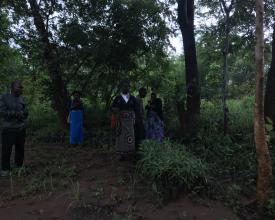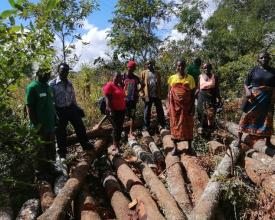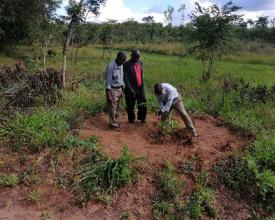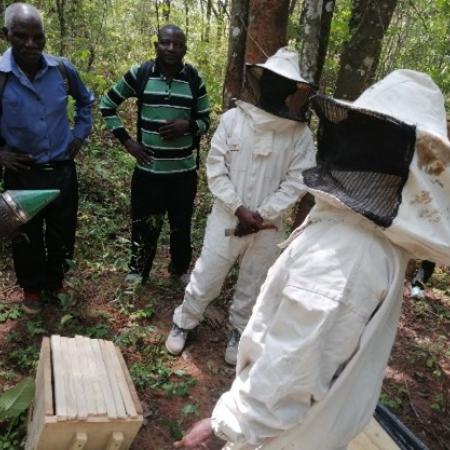
Forestry Restoration for better livelihoods through Assisted Natural Regeneration (ANR) and Biodiversity conservation in Kaning'ina Forest Reserve and communities surrounding it.
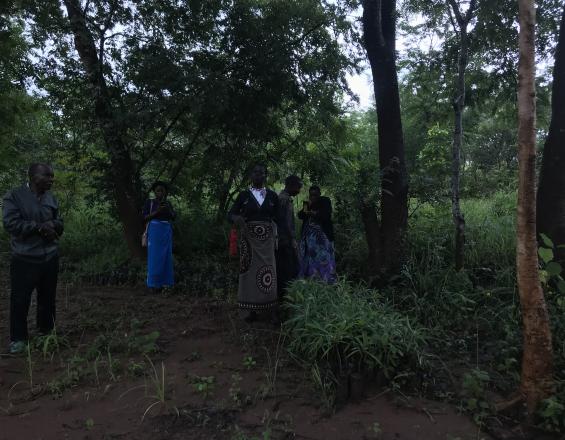
In support of the Government of Malawi's National Forestry Landscape Restoration (FLR) Strategy, and the NKhatabay District Council's FLR Action Plan, the Department of Forestry (DoF), with support from Modern Cooking for Healthy Forests activity has engaged local communities using data (e.g., from the National FLR Assessment, the National Forest Inventory, and the Deforestation Assessment) to prioritize degradation hotspots in Kaning'ina Forest Reserve and adjacent landscapes. The degradation hotspots are focal points for "restoration" interventions--including a number of hotspots in/around the Kaning'ina Forest Reserve.
Context
Challenges addressed
Overreliance on natural resources has led to high levels of degradation in the Kaning’ina Forest reserve. Communities surrounding the reserve are heavily dependent on it for resources for both agrarian and economic needs. The unsustainable harvesting of fuelwood for energy and timber has resulted in endangering tree species. On the other hand, the lack of employment due to population increase is still putting a lot of pressure on natural resources. This is another contributing factor to illegal charcoal production in the area. Due to illegal charcoal production, there is a rise in deforestation. It is due to this high rate of deforestation that another problem is on the rise, the drying up of rivers. Kaning’ina mountain is a source of many rivers like Kavuzi, Luwazi, and Lunyangwa. Deforestation has resulted in many of such rivers drying up thereby affecting agriculture productivity downstream since most people depend on irrigation farming. This is further affecting livelihoods in the area.
Location
Process
Summary of the process
For meaningful progress in restoration efforts, there is need for people in the community to actively participate. Community participation thus becomes a major factor in the restoration of degraded landscapes at scale. Thus, the more the people in the community are participating, the more the activities they will be able to do. Capacity building targeting community leaders and youth is also key for decision making. This is key for the sustainability of the activities because the youth will be able to go on and also get trained in leadership roles in the community. This will help forestry restoration efforts as they do take a considerable amount of time to take effect. Partnership with other stakeholders in the area also helps in restorations efforts by sharing of ideas as well as other resources like revenue and inputs. The more the inputs that can be used in a community, the better the efficacy of the work. Partnership also brings about capacity building in all partners involved where the other may impart the community with the technical know how and the other partners may learn from the local knowledge on how things have been done local when it comes to restoration.
Building Blocks
Strong leadership and partnerships key to restoration
Forest landscape restoration efforts require a willing and enthusiastic social system led by Traditional Leaders who are traditionally custodians of customary land. The success of this solution has largely hinged on strong leadership and partnerships within.
Enabling factors
- Community Participation is a key enabling factor that is required for meaningful progress in the activities that are happening in the community. This is because without active participation they will not be any progress.
- The political environment also plays a part in enabling restoration. Political leadership that provides guidance to communities for sustainable management of forest resources is always preferred.
Lesson learned
- Community Expectations. It is very important to manage the community's expectations through most activities concerning natural resource management. Most communities expect immediate results when it comes to working on forestry restoration and this presents a problem where they can get discouraged like some community members not participating in the activities.
- Partnership is Key. For a smooth process of activities, the partnership is key between community members, government officials as well as Non-governmental organisations. It defines the roles to be played by all stakeholders
- Leadership. Leadership determines the type of natural resources governance. Strong community leadership has been found to contribute to the better management of forests.
- Youth participation is key. In order to have sustainable development, youth involvement is key since youth are the leaders of tomorrow.
Empowerment of all actors involved is key
The success of forest management and restoration efforts has also hinged on the knowledge and skills acquired by the local forest organizations such as Village Natural Resources Management Committees. This has enabled the committee members to successfully implement ANR and fire prevention activities while adhering to good leadership skills to allow increased participation in restoration activities.
Enabling factors
Community empowerment is a key enabling factor to consider within this building block because activities being implemented by the community members are as a result of the trainings/capacity building efforts by committed extension workers and other community leaders
Lesson learned
- Training acts as an incentive for communities to participate in restoration efforts because the knowledge gained is applied on their land.
Impacts
So far, approximately 90 ha of forest area is under restoration activities led by these communities. In addition to this, the efforts are involving a number of households i.e over 200 households showing a positive outcome to restoration efforts. Several communities are involved in nursery establishment of tree species rarely found in the reserve. The raising of such seedlings is contributing to species preservation as well as the maintenance of biodiversity in the area. It is worth noting that some of the seedlings being raised are also on the endangered species list such as Adina microcephala locally known as Mung’ona that are being kept from extinction through this method. In addition, livelihoods are also being improved and individuals have started selling seedlings as an income-generating activity. In addition to this, there is also an increase in the number of forest-friendly enterprises including beekeeping. Due to these business opportunities, communities are geared to engage in forest-friendly activities. So far, most VNRMCs in the area are involved in beekeeping and nursery management. The restoration efforts have also contributed to river restoration from rivers coming from the mountain positively affecting irrigation schemes at Mpamba and Kawalazi and ultimately helping thousands of families in the area.
Beneficiaries
- Communities surrounding the mountains that are selling seedlings and mushrooms
- Communities living downstream who depend on irrigation
- CBOs involved in Beekeeping sell honey aquaculture
- Residents of Mzuzu benefit from water supply
Story

Kapalapata village, located in Nkhatabay district in Malawi, is a source of inspiration. In the year 2015, the Kapalapata village had been facing high shortage of firewood due to the over-harvesting of forestry resources from all the community forests in the area. Women in the area had to travel long distances to collect firewood. It is for this reason that the community came together in 2015 to establish Village forestry areas as a way reducing pressure on the existing forests.
The village was able through Assisted natural regeneration and fire management practices, to recover about 7 hectares of one Village forest area (VFA). By the year 2020, the community had gone a step further and started to establish nurseries to grow tree seedlings raising both indigenous and hybrid tree species. Originally, the nurseries were raised to help teach surrounding communities about seedling raising as well as sharing of the seedling to encourage afforestation efforts in the communities. Later on, the seedlings were sold as well as planted in the communal forest to help in enhancing livelihoods.
It is due to the good management in the area, that some of the streams that are surrounding the VFA started to recover and flow once more. This opened an opportunity for the community to be involved in fish farming by opening ponds around the VFA. This has helped the families in the village find another source of income as well as revenue that they get from the fish farming happening in the area. In addition to this, they have even inspired the youth in the area to be involved in forest management by looking at the benefits the VFA is bringing. The youth of the area are also on their own managing 1.7 hectares of land as well as raising nurseries as a way to support themselves.
Currently, the Kapalapata community is investing in other forest-friendly businesses such as beekeeping helping further in the development of the community. It is through forest management that the community has a number of community-based organizations in the area that are depending on beekeeping including the youth and the village natural resources management committee. It is through the sustainable harvesting of the community forest resources that the community was able to source materials to build a community hall that is also used as preschool for the community children. This is showing how sustainable forest management has helped the Kapalapata community in development.
